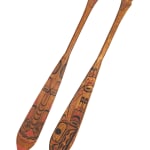UNIDENTIFIED ARTIST, KAIGANI HAIDA
unsigned.
LOT 19
ESTIMATE: $5,000 — $8,000
Historical Northwest Coast canoe paddles, like the canoes themselves, differ in style and form from one First Nation to another. This pair of paddles, small enough to have been made to carry in dance performances, is nonetheless made in the traditional style from the islands of the northern coast, among the Kaigani (Alaskan) Haida people. The greatest width of the blade is near to the pointed tip, the blade tapering steadily in width from there to the base of the hand grip, where small shoulders aid in the transition from flat blade to an oval grip. The grip area of the handle shaft steadily expands until it equals the width of the integral top-grip, where a cut-out on each side curves in narrower than the grip itself. These dimensions make for a paddle that is comfortable to hold and manipulate, and strong enough to pull volumes of water toward the paddler.
The design work on the paddles is in a late nineteenth-century style, each image representing a sea creature of uncertain identity, possibly mythological. The Haida equivalent of the dreaded sea monster of the Tlingit, Gonakadeit, is known as Konankada, with a powerful whale-like tail and a large carnivore’s head, capable of slipping through the seas and traveling on land. This may be the intended subject of these fine, late nineteenth-century paintings.
Steven C. Brown
Provenance
A Vancouver Collection.Exhibitions
Historical Northwest Coast canoe paddles, like the canoes themselves, differ in style and form from one First Nation to another. This pair of paddles, small enough to have been made to carry in dance performances, is nonetheless made in the traditional style from the islands of the northern coast, among the Kaigani (Alaskan) Haida people. The greatest width of the blade is near to the pointed tip, the blade tapering steadily in width from there to the base of the hand grip, where small shoulders aid in the transition from flat blade to an oval grip. The grip area of the handle shaft steadily expands until it equals the width of the integral top-grip, where a cut-out on each side curves in narrower than the grip itself. These dimensions make for a paddle that is comfortable to hold and manipulate, and strong enough to pull volumes of water toward the paddler.
The design work on the paddles is in a late nineteenth-century style, each image representing a sea creature of uncertain identity, possibly mythological. The Haida equivalent of the dreaded sea monster of the Tlingit, Gonakadeit, is known as Konankada, with a powerful whale-like tail and a large carnivore’s head, capable of slipping through the seas and traveling on land. This may be the intended subject of these fine, late nineteenth-century paintings.
Steven C. Brown
Join our mailing list
* denotes required fields
We will process the personal data you have supplied in accordance with our privacy policy (available on request). You can unsubscribe or change your preferences at any time by clicking the link in our emails.




